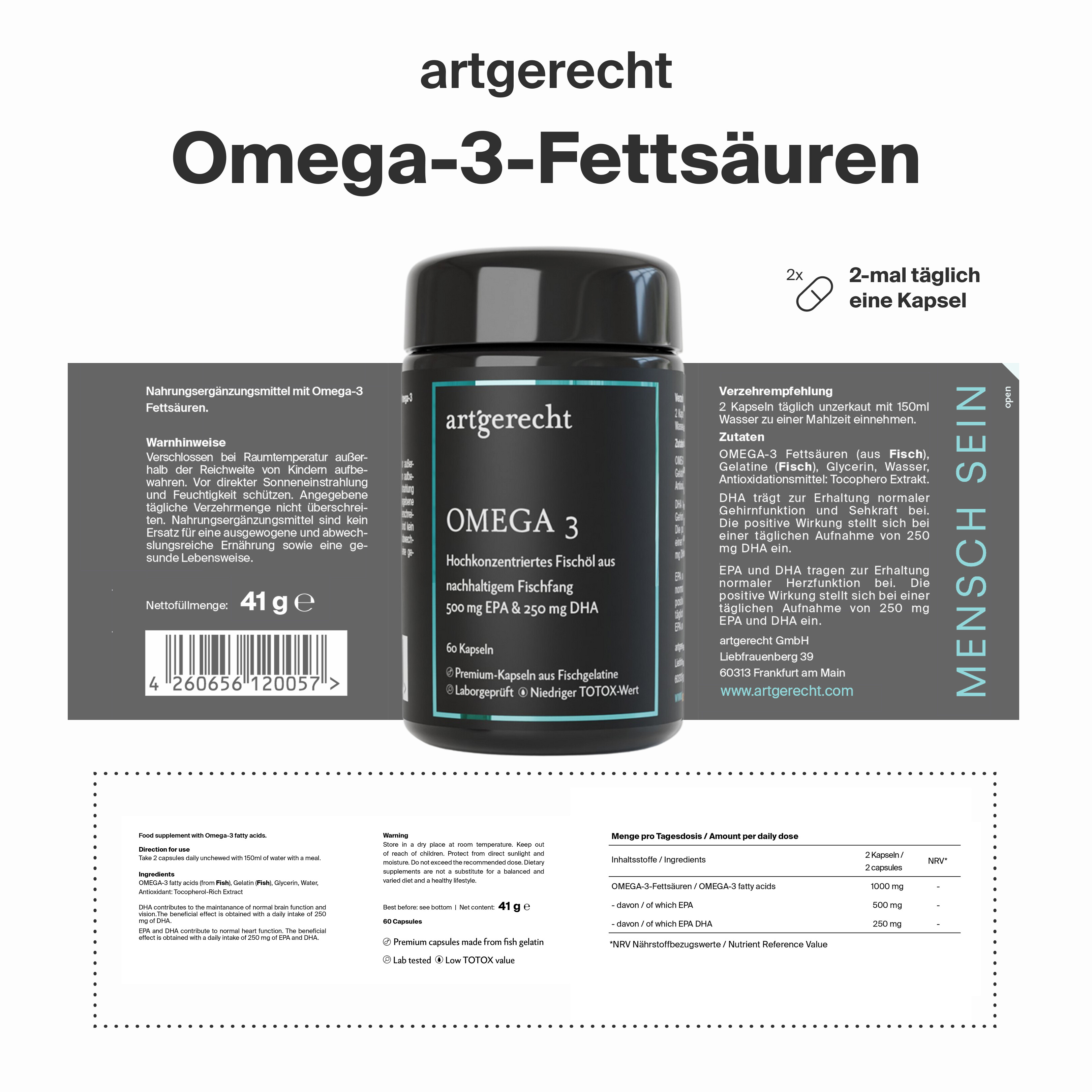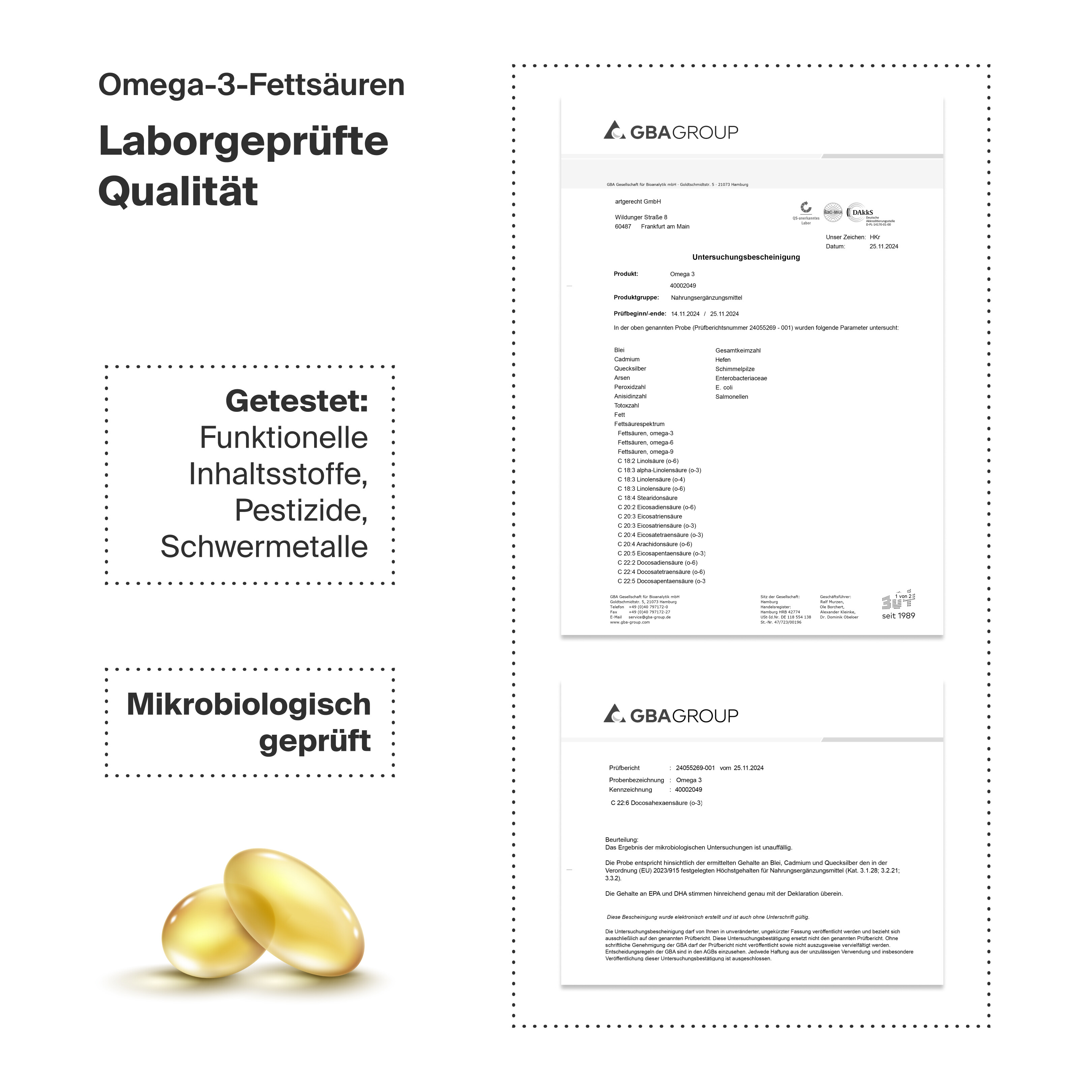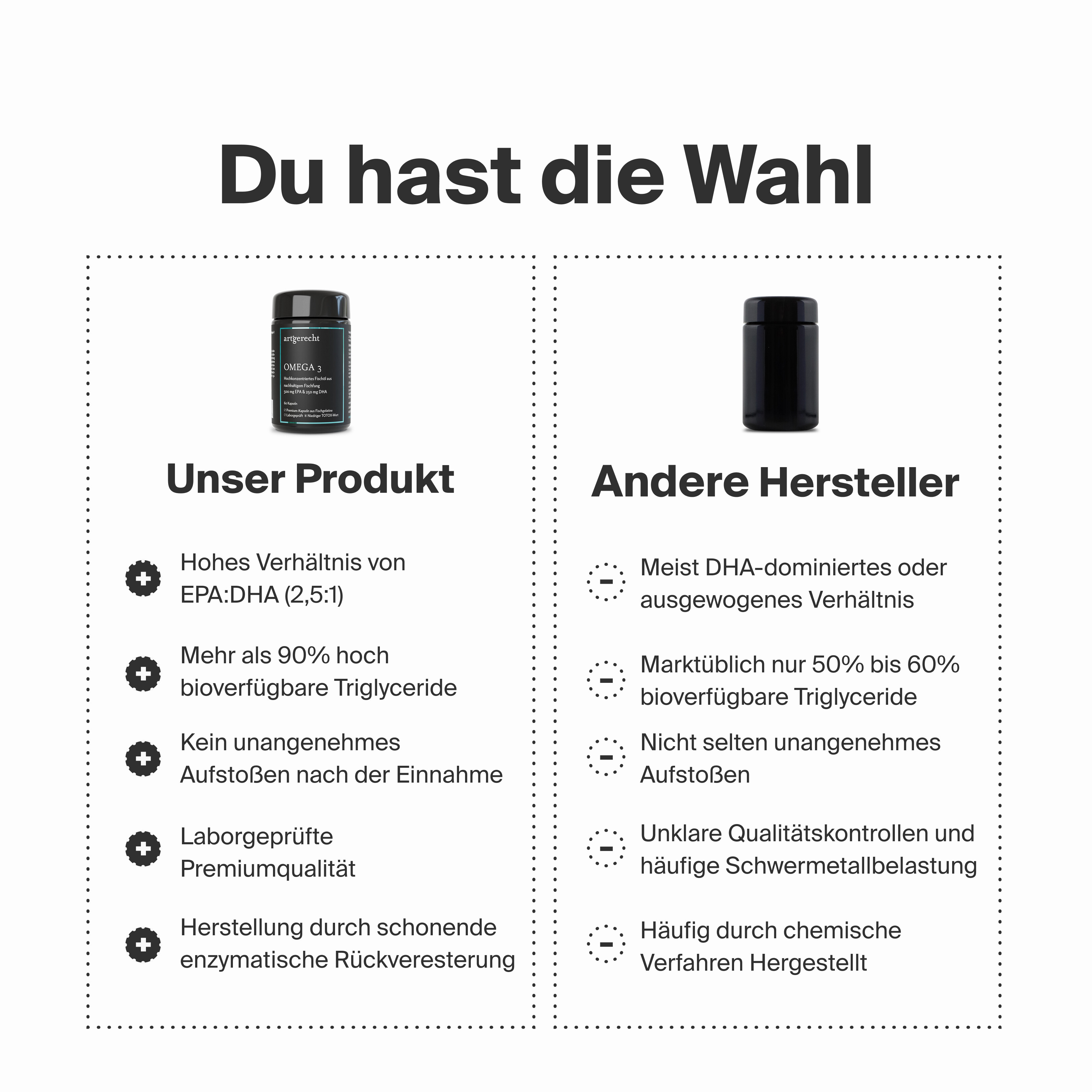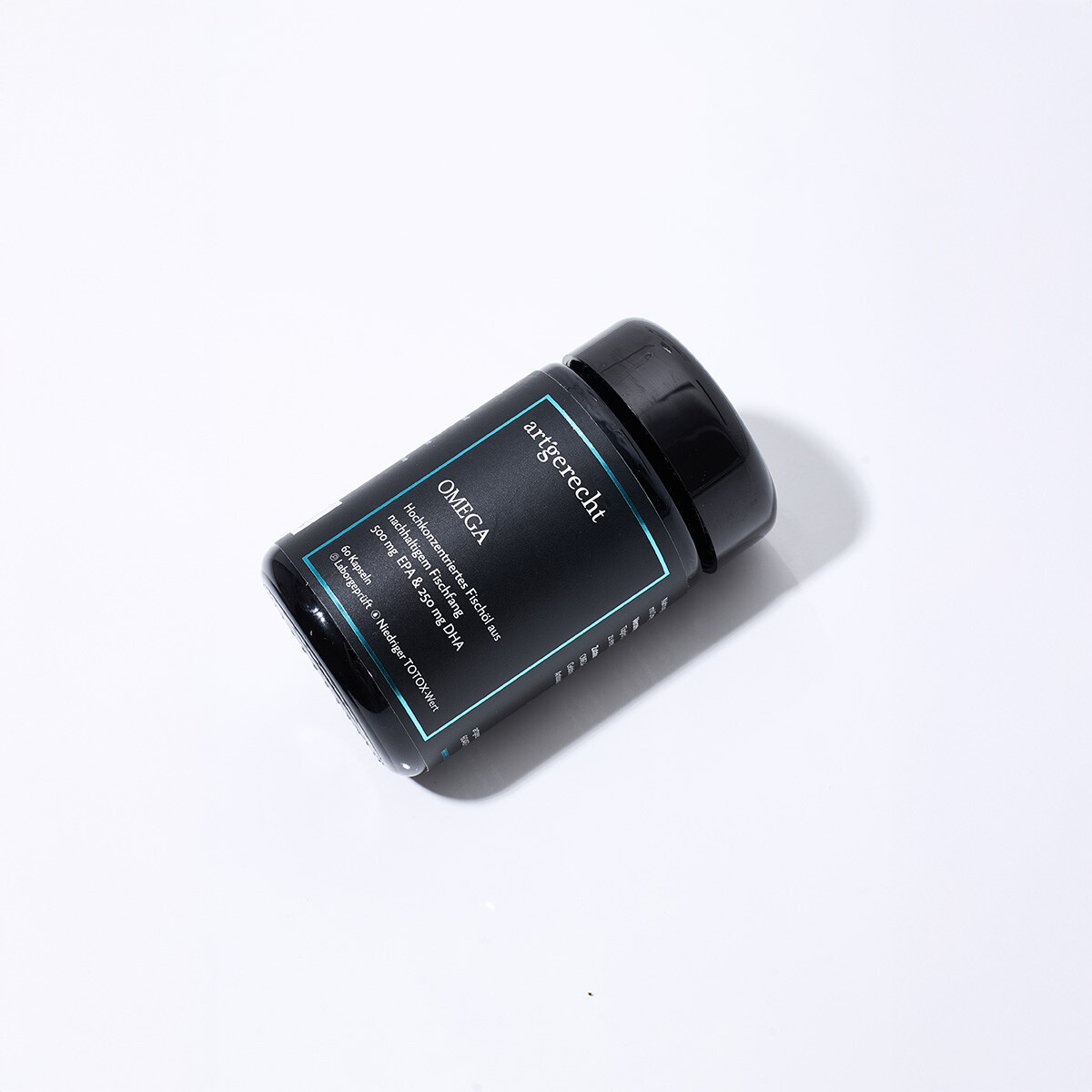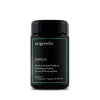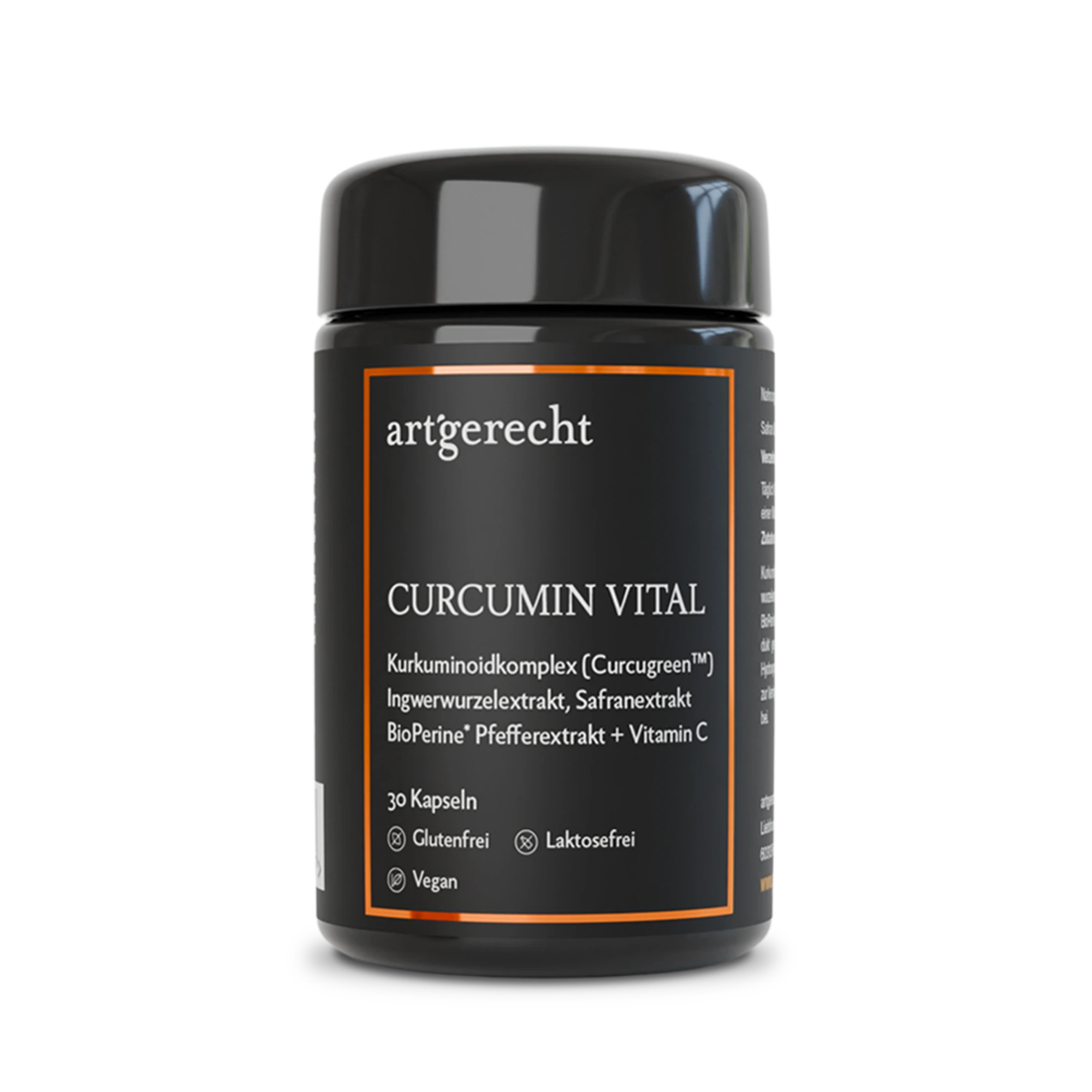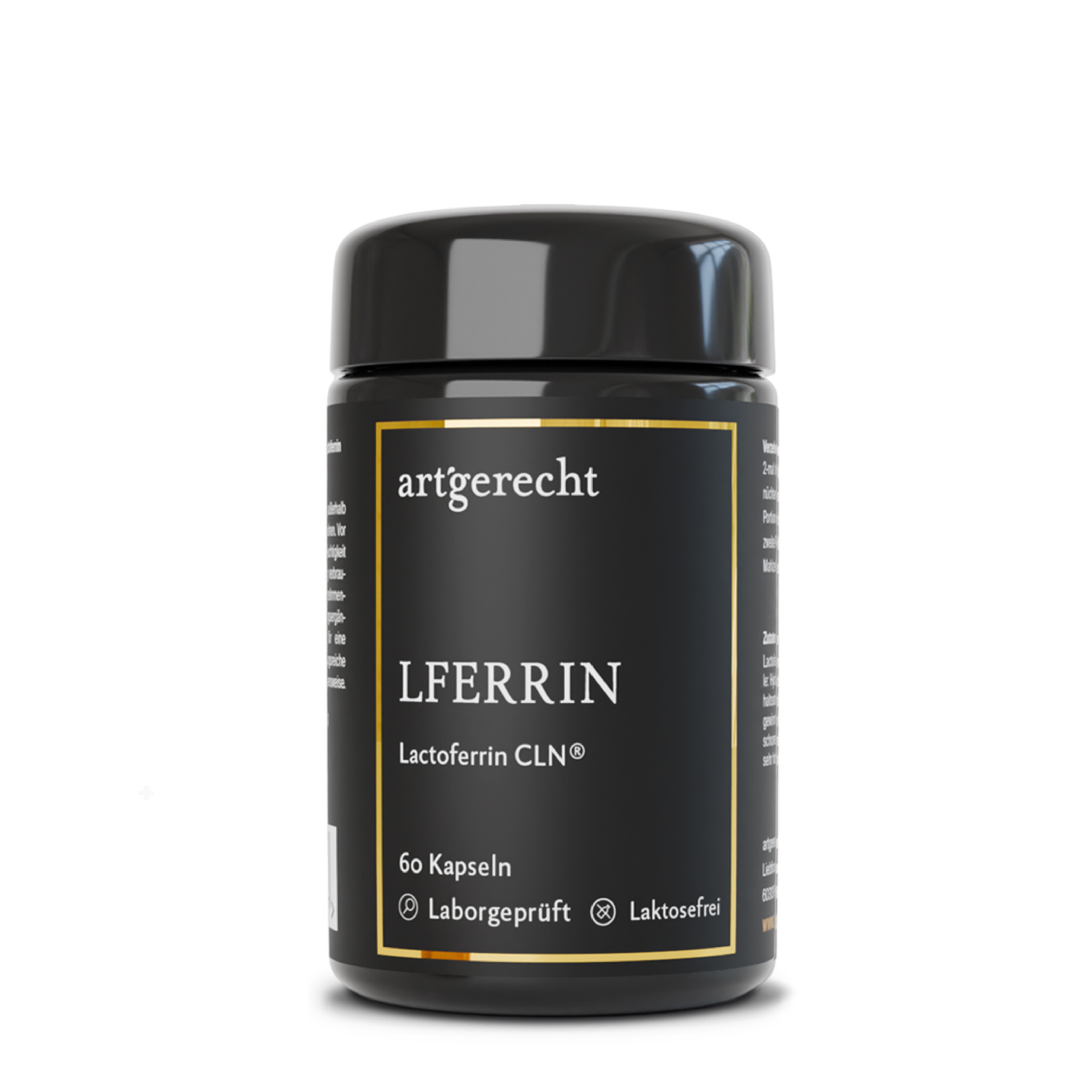Omega 3
- For daily support: contributes to normal brain function, vision & heart function
- Optimal EPA–DHA ratio & high bioavailability
- Very low TOTOX value below 7
- A product of the Cologne List®
- With pharmacy approval
€29.90
Prices incl. VAT plus shipping costs
Content:
0.047 kg
(€636.17 / kg)
Collect 29 Health Points (≈ €2.32)
Available, delivery time: 1-3 days
€29.90
Omega-3 fatty acids serve as building blocks for cell membranes or as energy carriers. They also contribute to normal brain function, the maintenance of normal vision, and normal heart function.
We obtain the Omega-3 fatty acids in premium quality from sustainable fishing and preserve their purity through a gentle extraction process.



What is Omega 3?
OMEGA is the product of choice for those who eat little or no fish, as it contains a high proportion of essential Omega-3 fatty acids EPA and DHA (Eicosapentaenoic acid and Docosahexaenoic acid). These are primarily found in fish, shellfish, and algae.
Omega-3 fatty acids are considered healthy fats that contribute to the maintenance of normal vision, heart and brain functions, as well as normal cholesterol levels. However, our body cannot produce them on its own, which is why we need to obtain them through food or supplementation. OMEGA provides these natural, healthy fats from the sea.
We obtain the Omega-3 fatty acids in premium quality from sustainable fishing and preserve their purity through a gentle extraction process.
Our OMEGA has an exceptionally low TOTOX value (10).

Natural supplements & superfoods in uncompromising quality

Why Omega 3 from artgerecht?
- For optimal daily supply
- Optimal EPA-DHA ratio
- High bioavailability
- DHA contributes to the maintenance of normal brain function and vision1
- EPA and DHA contribute to the maintenance of normal heart function2
- Ingredients exclusively from sustainable wild catch
- Capsule material also made 100% from fish oil
- High purity of ingredients due to gentle extraction process
Scientific background about Omega 3
Fish has always been an integral part of the human diet. However, our modern eating habits are often rich in Omega-6 and relatively low in Omega-3 fatty acids. This imbalance can manifest in inflammatory processes. Inflammation is partly caused by Omega-6 fatty acids (arachidonic acid), while Omega-3 fatty acids (eicosapentaenoic acid and docosahexaenoic acid) counteract this process. This works only when Omega-6 and Omega-3 fatty acids are in a good balance (an optimal ratio would be 2:1).
Omega-3 fatty acids, especially eicosapentaenoic acid (EPA) and docosahexaenoic acid (DHA), are essential for numerous physiological processes in the human body. They play a crucial role in the structure of cell membranes, influence the fluidity and functionality of cells, and are vital for neuronal health. Studies have shown that adequate intake of Omega-3 fatty acids is linked to a reduced risk of cardiovascular diseases and neurodegenerative disorders.
In contrast, Omega-6 fatty acids, which include linoleic acid and arachidonic acid, are also essential but tend to support inflammatory processes when consumed in excess. These fatty acids are found in many vegetable oils and processed foods, contributing to their overconsumption in the Western diet. Excessive intake of Omega-6 fatty acids can lead to dysregulation of inflammatory processes in the body, which may promote chronic inflammation.
The ratio between Omega-6 and Omega-3 is crucial for maintaining health. A balanced ratio not only supports optimal immune function but also promotes heart health and cognitive function. Nutrition experts recommend increasing the intake of Omega-3-rich foods like fatty fish, flax seeds, and chia seeds to improve the ratio. A conscious adjustment of dietary habits can therefore help to maximize the health benefits of these essential fatty acids.


Ingredients
OMEGA-3 fatty acids (from fish), gelatin (beef), glycerin, water, antioxidants: tocopherol extract
| Content | Per Daily Dose (2 Capsules) |
|---|---|
| OMEGA-3 Fatty Acids | 1,000 mg |
| Of which: | |
| - EPA | 500 mg |
| - DHA | 250 mg |
Frequently Asked Questions
What are Omega-3 Fatty Acids?
Omega-3 fatty acids belong to the group of polyunsaturated fatty acids and are essential. This means they must be obtained through food and cannot be produced by the body itself. The most important Omega-3 fatty acids are α-linolenic acid (ALA), docosahexaenoic acid (DHA), and eicosapentaenoic acid (EPA). ALA is a plant-based Omega-3 fatty acid, while DHA and EPA are primarily found in marine animals, but also in algae.
What are the Functions of Omega-3 Fatty Acids?
Omega-3 fatty acids (DHA*) serve as building blocks for cell membranes or as energy carriers. They also contribute to normal brain function, the maintenance of normal vision, and normal heart function. Replacing saturated fatty acids with monounsaturated or polyunsaturated fatty acids in the diet also supports the maintenance of normal blood cholesterol levels. A daily intake of 250 mg EPA and DHA can lead to positive effects.
*Correspond to the health claims of the European Commission, confirmed by the European Food Safety Authority (EFSA)
Why is the Right Ratio of Omega-3 to Omega-6 Important?
Fish has always been an essential part of the human diet. However, our modern eating habits are often high in Omega-6 and low in Omega-3 fatty acids. This imbalance can be noticeable in relation to inflammation processes. Inflammation is partly caused by Omega-6 fatty acids (arachidonic acids). These processes are inhibited by messenger substances from Omega-3 fatty acids (eicosapentaenoic acid and docosahexaenoic acid). However, this only works if Omega-6 and Omega-3 fatty acids are in a good ratio (the optimal ratio is 2:1).
Where Can Omega-6 Fatty Acids Be Found?
Omega-6 fatty acids are primarily found in plant-based products such as sunflower, soybeans, corn, margarine, as well as in grains, nuts, and pumpkin seeds. Nowadays, they can also be found in many processed or fried foods, as well as in meat and sausages, if the animals have been fed Omega-6-rich food. A low-fat diet is not natural and can lead to a deficiency in Omega-3 fatty acids. Therefore, if you do not consume fatty fish regularly, you should ensure your intake through other sources.
Why is Fish an Essential Part of a Natural Diet?
In the past, humans were primarily gatherers and fishermen, rarely hunters. The reason is simple: seas and proximity to water have been an important food source for humans for millions of years – and shellfish were easier to "catch" than antelopes. Fish and shellfish were eaten whole, including the internal organs, and were the main source of Omega-3 fatty acids.
How is OMEGA Made?
With a very elaborate manufacturing method (MSET™ technology), we extract our fish oil in a particularly gentle manner, which preserves the high quality of the ingredients. MSET™ stands for Molecular Selective Enriching Technology. This technology allows the ingredients of Omega-3 fats to be separated and purified in a particularly gentle manner. The low-temperature process prevents the degradation or transformation of fats and simultaneously increases the product's purity. This process distinguishes OMEGA from conventional Omega-3 supplements.
Where Does the Fish in OMEGA Come From?
The fish used to extract the fats for OMEGA is sustainably caught off the coast of Peru. The anchovies used are, of course, tested for heavy metals, pesticides, and other unwanted substances, and the levels are well below legal limits. Sustainable fishing and harvesting not only have a positive impact on the environment, but also benefit us humans.
What ingredients are in Omega 3?
| Content | Per Daily Dose (2 Capsules) |
|---|---|
| OMEGA-3 Fatty Acids | 1,000 mg |
| Of which: | |
| - EPA | 500 mg |
| - DHA | 250 mg |

Customer reviews
Recommended additions
Popular customer combinations and recommended additions to Omega 3.





